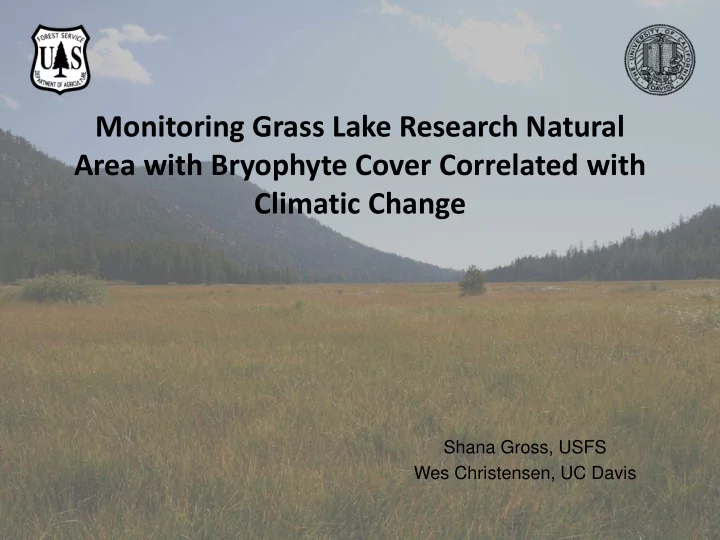

Monitoring Grass Lake Research Natural Area with Bryophyte Cover Correlated with Climatic Change Shana Gross, USFS Wes Christensen, UC Davis
Peatlands • Cover 3% of the Earth’s surface 1 – Make up 0.1% of the mountain landscape • Wetlands with thick organic soil 1 – Perennially saturated soils – Low oxygen subsurface conditions • Provide island habitat diverse flora and fauna • Help regulate stream flow and temperatures – Peat is a thermal insulator – Acts as a sponge • Sierra Nevada peatlands are thought to be sustained groundwater (fens 2 ) – High evapotranspiration – Low summer precipitation 1 Clymo 2004; 2 Cooper et al. 1998
Sierra Nevada Fens • Often the only source perennial moisture • Support ecosystems with high biodiversity • Sensitive plant communities • CA National Forests are directed to maintain, restore, and/or enhance fens
Grass Lake • Largest peatland in Sierra Nevada (93 ha) • South Lake Tahoe, Luther Pass, CA • Designated as a Research Natural Area in 1991 • Tahoe Regional Planning Agency uncommon plant community
Fens are climatically sensitive ecosystems 1 • Climate change may increase impacts to fens 3 – Increase evapotranspiration – Decrease water table – Decrease peat volume due to increased decomposition – Change in the plant community • Climate change predictions for Tahoe Basin include 2 : – Increased air temperature – Shift from a snow to a rain dominated regime – Earlier snowmelt – Increased interannual variability • We hypothesize that hydrologic changes are one of the largest threats to Grass Lake (and peatlands in general) 1 Gignac 2001; 2 Coats 2010; 3 Cooper et al. 1998
Bryophytes • Form the foundation for peatland plant communities 2 • More sensitive to climatic changes than vascular plants 2 • Good ecological indicator species: – Monitored with simple 1 repeatable field methods – Responds relatively quickly to changes 1 – Has a link to societal values 1 1 McCune 2000; 2 Vile et al. 2001
Meesia triquetra Sphagnum spp. • GL largest Sphagnum • CA Forest Service FS “bog” in CA Sensitive Species • Indictor climate change 2 • Uncommon due to limited distribution • Intimately tied to habitat 1 hydrology 3 1 Montagnes 1990; 2 Gignac 2001; 3 Andrus 1986
Field Methods
Geostatistics -2 g 10 • ArcMap 9.3 Geostatistical 1.37 Analysist 1.09 • Ordinary krigging 0.82 – Spherical model 0.55 0.27 – Lag of 15 meters • Visually fit semivariograms: 0 0.38 0.75 1.13 1.5 1.88 2.25 2.63 3 -2 Distance, h 10 – Nugget = variance at small Meesia triquetra 2010 semivariogram, minor axis 20 0 distances -2 – Sill = variance at large distances g 10 – Range = distance with constant 1.37 variance 1.09 • Anisotropy – major axis 110 0 0.82 0.55 • One sector neighborhood 0.27 1:20 neighbors 0 0.38 0.75 1.13 1.5 1.88 2.25 2.63 3 -2 Distance, h 10 Meesia triquetra 2010 semivariogram, major axis 110 0
Cover Categories • Sparse cover: 0-5% • Intermediate cover: 5-50% • Dominant cover: 50-100%
Validation Year 2010 2009 2004 2010 2009 2004 Correct Prediction 91% 91% 86% 87% 78% 84% Over Predicting 6% 8% 6% 8% 12% 13% Under Predicting 3% 1% 8% 5% 10% 3%
Meesia triquetra 2004 2009 2010 2009 Minus 2010
Sphagnum spp.: Sphagnum inundatum , S . lescurii , and S. squarrosum 2004 2009 2010 2009 Minus 2010
Climate Data • Water Year • Total Growing Days – Echo Peak SNOTEL 1 – >2 0 C 2 ave daily temperature • Growing days since peak spring flow – Echo Peak SNOTEL 1 ; USGS Meyers gauge 3 – >2 0 C ave daily temperature post peak stream flow • Total stream discharge after peak stream flow – USGS Meyers gauge 3 1 http://www.wcc.nrcs.usda.gov/snow/snotel-precip-data.html; 2 Gignac et al. 1991; 3 http://waterdata.usgs.gov/nwis/rt
Bryophyte Area 35 30 and Climate 25 Hectares 20 400 300 15 Total stream discharge after spring peak flow (cubic meters per 10 350 250 5 300 0 Number Growing Days 200 M. triquetra M. triquetra Sphagnum Sphagnum 250 2009 2010 spp. 2009 spp. 2010 second) 200 150 5 to 50% Cover 50 to 100% Cover 150 100 100 50 50 0 0 2004 2005 2006 2007 2008 2009 2010 Water Year Total Spring Discharge (CMS) Total GD GD Post Peak Flow 1 ha = 2.47 acres
Summary • Since 2004 – Rapid contraction and expansions of bryophyte cover – Decrease of Meesia triquetra – Increase of Sphagnum spp. – Increase total spring discharge (magnitude varies year) – Number Growing Days vary by year • Look to other potential climate variables explain trend • Continue Monitoring
Acknowledgements • Field Personnel • Funding – Blake Engelhardt – Southern Nevada Public Lands Management Act – Alison Stanton – Beth Brenneman – Cristina McKernan – Emily Millar – Erik Frenzel – Eva Olin – Jody Fraser – Justina Fedorchuk – Katie Heard – Kim Gorman – Stu Osbrack
Recommend
More recommend